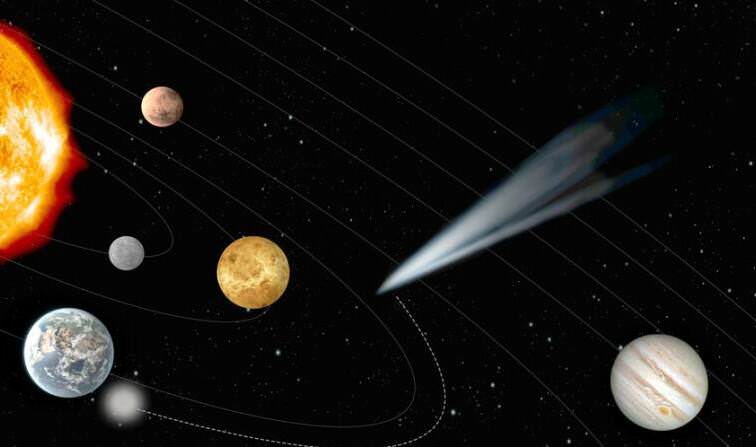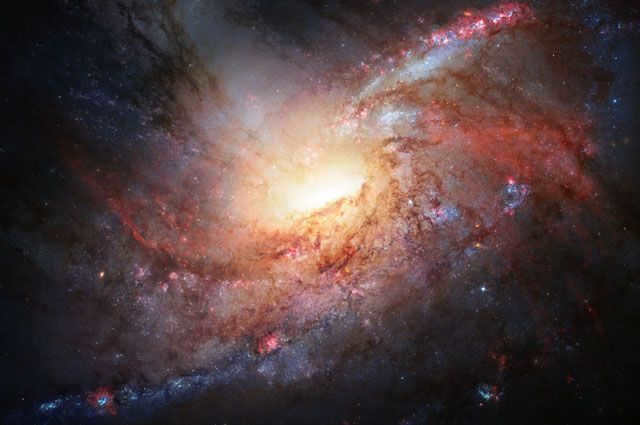
– What is the reason why only Saturn possesses rings?
– That’s the common belief, and it’s a fairly typical perspective for those who are not well-versed in astronomy. However, the reality is much more complex. In the 1950s, the Soviet scientist Vsekhsvyatsky proposed the idea that there were meteor clouds surrounding all the giant planets. When the American space probe “Pioneer” made its first journey to Jupiter, it confirmed the existence of rings around the planet. The only difference is that these rings are made up of a substance that doesn’t reflect light very well. This is why we can’t fully see Saturn’s rings either. In reality, these rings extend into space for hundreds of thousands of kilometers beyond what we can observe from Earth. Similar formations have also been observed around Uranus and Neptune. But here’s an even more surprising fact: even Earth has its own ring. It’s a thin, dusty ring that is barely perceptible, but it is indeed there. All of these rings are composed of matter originating from comets and meteors, which are held in the planets’ orbits by gravity. Similarly, our Sun also has a vast collection of comets, meteorites, and asteroids in its vicinity.
The boundary of the unknown
– Can one travel to the outermost reaches of the cosmos?
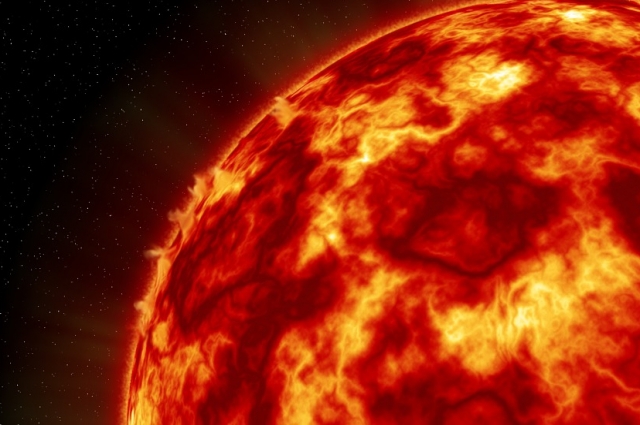
– Why doesn’t the Sun provide warmth during the winter?
– There is a misconception that the Earth is not warmed by the Sun during the winter months. This idea is closely linked to a common misunderstanding about the causes of seasonal changes. Many people, including schoolchildren, students, and even well-educated individuals, often mistakenly believe that the onset of winter or summer is determined by the distance between our planet and the Sun. However, it is important to note that while it may be winter in our hemisphere, it is simultaneously summer in the opposite hemisphere. In reality, the change of seasons is solely influenced by the tilt of the Earth’s axis in relation to the Sun, which varies periodically. During the summer months, the Sun’s rays hit the Earth’s surface in our part of the world at nearly a right angle, resulting in effective heating. Conversely, during the winter months, the Sun appears lower in the sky, causing the angle of sunlight to be more oblique. As a result, the rays reach the surface tangentially, seemingly gliding over it and providing less warmth.
– What will happen to the Sun in the future?
– The Sun undergoes a continuous process of burning approximately 300,000 tons of matter every second. Although this may seem like a large amount to us, it is actually relatively small in relation to the Sun’s total mass. Scientists believe that the Sun, which has already been in existence for five billion years, will continue to live for at least that long, experiencing a series of evolutionary changes. However, its fate will not be the same as that of giant stars. Unlike them, the Sun will not end its life cycle with a dramatic supernova explosion. Instead, it will gradually expand and become a red giant, shedding its outer layers to form a stunning nebula. This nebula may be observed by future astronomers from distant locations. Eventually, the Sun will diminish in size, leaving behind only a brown or white dwarf.
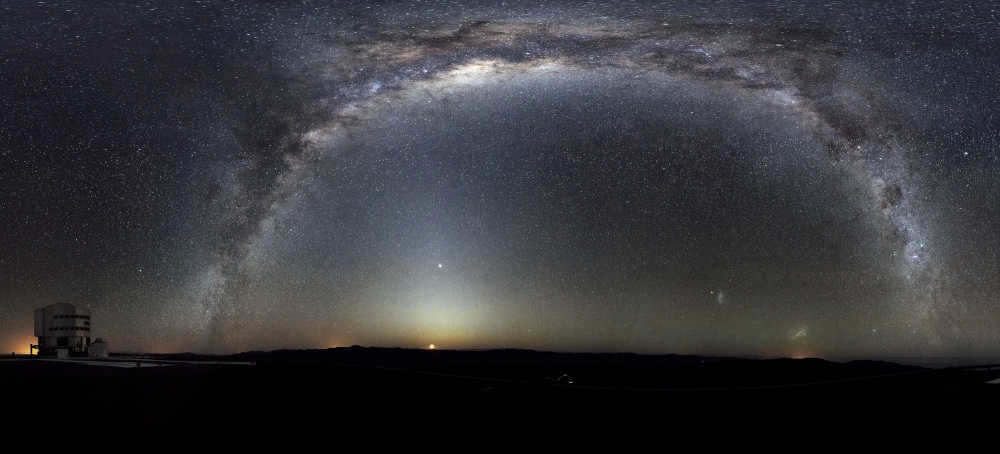
One who possesses the skill of patience will discover it
– Will humanity uncover existence elsewhere in the universe?
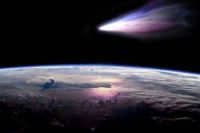
– How can you differentiate between a star and a planet by observing the celestial sphere?
– Identifying some planets in the solar system can be quite straightforward. For instance, Venus stands out due to its incredibly bright appearance in the morning and evening sky, immediately catching the observer’s attention. Jupiter also shines brightly, making it easily distinguishable. However, for the average person, differentiating most planets from stars in the sky can be challenging. It requires either a good understanding of constellations or consistent observations over a month or longer. The reason for this difficulty lies in the fact that stars all rise and set at the same time, while planets slowly move among the stars, creating a slight shift in their positions. With prolonged observation, it becomes noticeable that planets trace out figure-eight patterns, which reflect their motion around the Sun. It’s worth noting that these visual effects have nothing to do with the misconception that planets and stars have different movements or “play” differently in the sky. Instead, they are solely influenced by the Earth’s atmospheric properties.

Space Variables
– Does the Sun remain stationary while the Earth orbits around it?
– The Sun is in constant motion, along with the eight planets of our solar system and countless asteroids, as they all orbit the center of the Milky Way galaxy. The Sun travels at an impressive speed of 250 kilometers per second, taking nearly a million years to complete a full revolution around the center of our galaxy. Furthermore, the Milky Way itself is not stationary, as it is part of a larger structure known as a metagalaxy, which includes the Andromeda Nebula and several other galaxies. This grand arrangement is a testament to the force of gravity, which governs the movements of celestial bodies and shapes the universe.
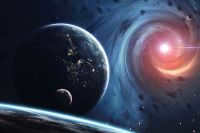
– Why was the title of planet taken away from Pluto?
– The reason behind this dramatic decision is actually quite simple. In 2006, Pluto lost its status as a planet not because of its size, as many believe. The issue lies in the International Astronomical Union’s rules, which state that a planet’s orbital path should not be occupied by other objects. Earth, Venus, and Jupiter, for example, do not have any such objects in their orbits. Although Mercury is quite small, its orbit is clear of any extraneous objects, making it a planet. On the other hand, Pluto has multiple objects orbiting around it. The size of these objects doesn’t matter much; what matters is that they exist. As a result, Pluto became the first of a new class of celestial bodies known as dwarf planets. In fact, these space objects are now referred to as plutonids in honor of Pluto.
– Can we travel to Jupiter, the largest planet in our solar system?
– It is theoretically possible to fly to the massive planets – Jupiter, Saturn, Uranus, and Neptune, but it is impossible for a human to land on them due to their physical characteristics. Even with highly advanced spacecraft, attempting to land on these planets would be equivalent to attempting to land on the Sun. These planets have incredibly powerful hurricanes in their atmospheres, with wind speeds reaching several thousand kilometers per hour. For instance, Jupiter has had a colossal tornado that could contain three Earths for a minimum of four hundred years. Additionally, the atmospheric pressure on these giant planets is immense, rendering any vehicle in such an environment completely flattened. Furthermore, due to the gaseous nature of these planets, it is impossible to reach any solid surface. The core is unreachable due to the prohibitively high pressure.

Isn’t it incredible that gravity has the ability to both attract and repel? This statement is not just some hypothetical concept, but rather a real phenomenon known as the Great Repulsor. A team of scientists has credited this force with contributing to half of the speed at which our Galaxy travels through the vastness of space. This notion may seem bizarre and fantastical, but let’s delve deeper into its intricacies.
Initially, let’s take a look around and familiarize ourselves with our neighbors in . Throughout recent decades, we have acquired a substantial amount of knowledge, and the term “cosmography” is no longer just a concept from Strugatsky’s science fiction novels. It is now one of the divisions within contemporary astrophysics that focuses on mapping out the accessible portion of the Universe. The Andromeda galaxy serves as the closest neighbor to our Milky Way, visible to the naked eye in the night sky. However, it is unlikely that we will be able to observe several dozen more companion galaxies. These dwarf galaxies, which revolve around us and Andromeda, are incredibly faint, and astrophysicists are still uncertain if they have discovered all of them. Nonetheless, all of these galaxies (including the yet undiscovered ones), along with the Triangle Galaxy and the NGC 300 galaxy, form part of the Local Group of galaxies. Currently, there are 54 known galaxies within the Local Group, with the majority being the aforementioned dim dwarf galaxies. The Local Group spans over 10 million light-years in size. Alongside around 100 other galaxy clusters, the Local Group is a constituent of the Virgo supergroup, which measures more than 110 million light-years in size.
In 2014, a group of astrophysicists, led by Brent Tully from the University of Hawaii, made a significant discovery. They found that the supercluster, consisting of 30,000 galaxies, is actually part of a larger structure known as the Laniakea supergroup. This supergroup is already home to over 100,000 galaxies. However, there is still one more level to this cosmic hierarchy. The Laniakea supergroup, along with the Perseus-Pisces superscale, is part of the Pisces-Keith superscale complex. This complex is not only a galactic filament, but also a crucial component of the overall large-scale structure of the Universe.
Observations and computer simulations have verified that galaxies and clusters are not randomly distributed throughout the Universe, but instead create a intricate lattice-like arrangement with filamentary threads, junctions, and empty spaces, also known as voids. As Edwin Hubble demonstrated nearly a century ago, the Universe is expanding, and superclusters are the largest structures that remain intact due to the gravitational pull between them. In other words, to put it simply, the filaments are moving apart from one another due to the influence of dark energy, while the movement of objects within them is primarily governed by gravitational attraction.
And now, with the knowledge that there are countless galaxies and clusters in close proximity to us, exerting such strong gravitational forces that they even counteract the expansion of the Universe, it is time to pose the fundamental question: where is it all heading? This is precisely what a team of scientists, including Yehudi Hoffman from the Hebrew University of Jerusalem and the aforementioned Brent Tully, are endeavoring to answer. Their collaborative article, recently published in Nature, is founded on data obtained from the Cosmicflows-2 project, which has meticulously measured the distances and velocities of over 8,000 galaxies in our vicinity. The project was initiated in 2013 by the same Brent Tully and his colleagues, among whom is Igor Karachentsev, a highly esteemed Russian observational astrophysicist.
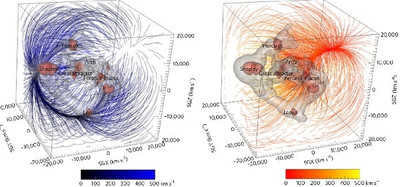
A visual representation of a portion of the local Universe is depicted in three dimensions. The velocity field of the closest superclusters, which can be observed through blue lines on the left, demonstrates a clear movement towards the Shapley Attractor. Conversely, on the right side, the red line illustrates the anti-velocity field, displaying the inverse values of the velocity field. These two fields converge at a specific point where they are expelled due to the lack of gravitational force in this particular region of the Universe.
So what is the ultimate destination? To find the answer, we need a precise map of the velocity of all massive objects in the nearby universe. Unfortunately, the data we have from Cosmicflows-2 is not enough to create this map. Despite being the best data available to humanity, it is incomplete, of varying quality, and contains significant errors. Professor Hoffman has employed Wiener estimation to analyze the existing data. This statistical technique helps separate the useful information from the noise that arises from radio electronics. By using this estimation, we can establish a basic model of how the system behaves (specifically, the Standard Cosmological Model). This model will dictate the overall behavior of all elements when there is insufficient additional data. However, when measurement data is available, it will take precedence in determining the motion of a particular galaxy.
The results obtained have confirmed our previous knowledge: the entire Local Group of galaxies is moving towards the Great Attractor, a gravitational anomaly located at the center of Laniakea. However, despite its name, the Great Attractor is not as massive as one might think. In fact, it is being pulled towards the much larger Shapley supergroup, towards which we are also heading at a speed of 660 kilometers per second. The problems arose when astrophysicists decided to compare the measured velocity of the Local Group with the calculated velocity based on the mass of the Shapley supergroup. It turned out that, despite its enormous mass (equivalent to 10,000 times the mass of our Galaxy), it could not account for our acceleration to such a high speed. Interestingly, scientists have constructed a map of anti-velocity, which shows vectors pointing in the opposite direction to our velocity vectors. This map has revealed an area that seems to repel us, located precisely on the opposite side of the Shapley supergroup. This repulsion is responsible for the exact speed that adds up to the desired 660 kilometers per second.
The entire structure of attractive and repulsive forces resembles an electric dipole, where the lines of force move between two charges.
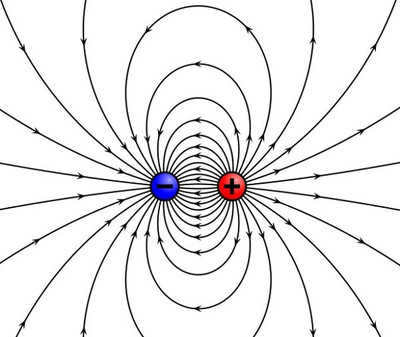
However, this goes against all the principles of physics – the existence of antigravity is simply impossible! What kind of extraordinary phenomenon is this? To find the answer, let’s envision a scenario where you are surrounded by five friends who are all pulling you in different directions with equal force. In this case, you would remain stationary, as if no one is exerting any force on you. However, if one of them, positioned on your right, were to release their grip on you, you would be propelled towards the left – in the opposite direction from them. Similarly, if a sixth friend were to join the five pulling friends and position themselves on your right, but instead of pulling you, they started pushing you, you would also be pushed towards the left.
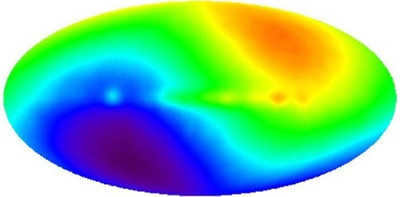
The COBE space observatory has provided us with a map of relic radiation. By analyzing the dipole temperature distribution, we have confirmed that our movement in space is taking us away from a colder region (indicated by the blue colors) and towards a warmer region (indicated by the yellow and red colors in this projection).
In the vast expanse of the Cosmos, galaxies and galaxy clusters serve as our celestial companions, exerting a gravitational force that tugs us in various directions. Were these cosmic entities distributed evenly throughout the Universe, we would find ourselves at a standstill, devoid of any motion. However, let us now contemplate a scenario where galaxies are absent on one side of our existence. In such a peculiar circumstance, our trajectory would be propelled away from this void, as if it were a powerful force pushing us away. This peculiar phenomenon is precisely what scientists refer to as the Great Repeller, an expansive region of several cubic megaparsecs that experiences an unusually low density of galaxies. Consequently, this region fails to counterbalance the gravitational influence exerted upon us by the countless clusters and superclusters situated in other sectors of the Universe. The nature of this galaxy-deficient space remains a mystery, yet one cannot deny the inconvenient positioning of the Great Repeller. It resides within the exclusion zone, a region of space concealed from us by our very own Milky Way galaxy, where numerous captivating and enigmatic astrophysical terms can be found.
The vast amount of stars and nebulae, along with the abundant presence of gas and dust, act as a barrier that prevents the unique light emitted by distant galaxies located on the other side of the galactic disk from reaching our observation. However, recent findings obtained through the utilization of X-ray and radio telescopes, which have the capability to detect radiation that is able to penetrate through gas and dust, have enabled scientists to compile a relatively comprehensive inventory of galaxies in the exclusion zone. Surprisingly, the Great Repulsor area is found to contain a minimal number of galaxies, leading to the speculation that it could potentially be classified as an immense desolate area within the cosmic structure, often referred to as a cosmic void.
Ultimately, regardless of the immense speed at which we traverse through the vastness of space, both the Shapley Attractor and the Great Attractor will forever remain out of reach. Scientists have estimated that it would take a multitude of times the age of the Universe itself to even come close. Therefore, no matter how advanced our understanding of cosmography becomes, its maps will continue to be of little use to interstellar travelers for the foreseeable future.
A galaxy, a magnificent entity composed of stars, gas, and dust, bound together by the powerful force of gravity. These colossal formations in the cosmos can vary greatly in shape and size. Nearly all celestial objects we know of are encompassed within a specific galaxy, including stars, planets, satellites, nebulae, black holes, and asteroids. Certain galaxies also possess copious amounts of undetectable dark energy. Due to the vast empty spaces that separate galaxies, they are often likened to oases within the cosmic desert…
| Spheroidal component | Whole galaxy | Yes | Very faint |
| Stellar disk | None or weak | Main component | Main component |
| Gas-dust disk | No | Yes | Yes |
| Spiral branches | No or only near the core | Yes | No |
| Active nuclei | Occur | Occur | No |
| 20% | 55% | 5% |
The Sun, which is the nearest star to us, is just one of the many stars that make up the Milky Way Galaxy. When you gaze up at the sky during the nighttime, it is difficult to miss the vast expanse of stars that fill the horizon. This celestial phenomenon was referred to as the Galaxy by the ancient Greeks.
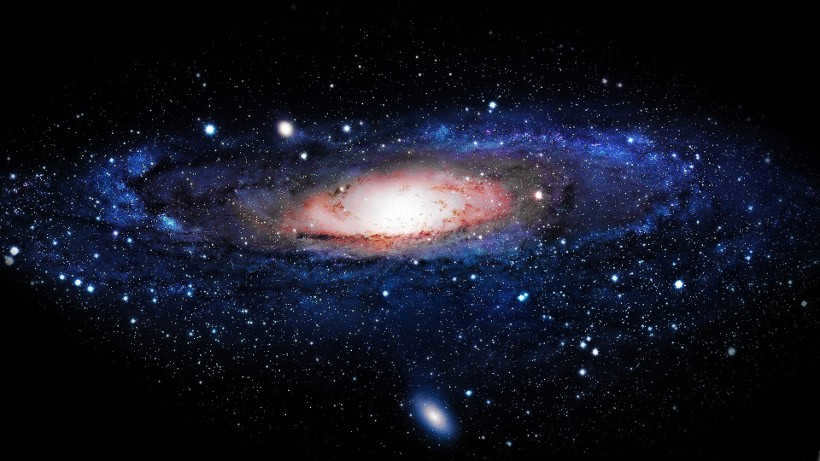
If we were to observe this stellar system from an external perspective, we would witness a flattened sphere containing more than 150 billion stars. The vastness of our galaxy is beyond comprehension. It would take a beam of light a hundred thousand Earth years to travel from one end to the other! The core of our Galaxy is occupied by the nucleus, from which massive spiral arms filled with stars extend. The distance from the Sun to the Galactic center is 30,000 light-years. The solar system resides on the outskirts of the Milky Way.
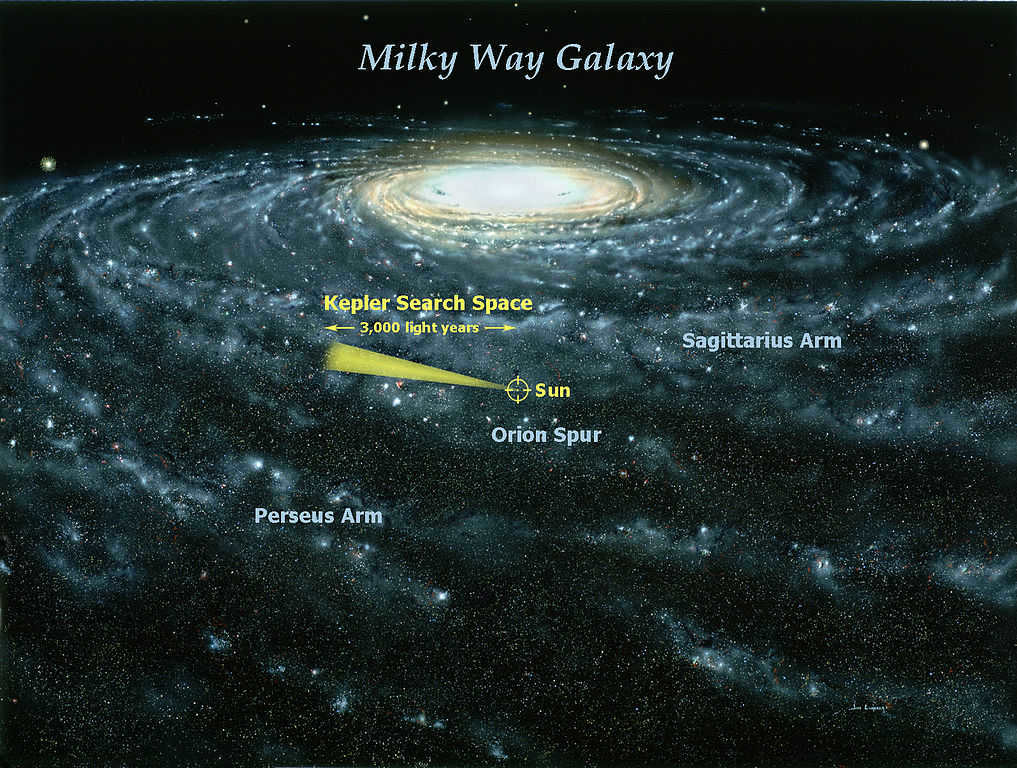
Stars within the Galaxy are uncommon despite the vast collection of celestial bodies. For instance, the space between adjacent stars is tens of millions of times larger than their own sizes. It can’t be stated that stars are randomly dispersed throughout the Universe. Their positioning is influenced by gravitational forces that maintain the celestial bodies within a specific plane. Galaxies are star systems that possess their own gravitational fields. In addition to stars, galaxies consist of gas and interstellar dust.
There are numerous other galaxies that comprise the entirety of the universe. The ones nearest to our own galaxy are situated at a distance of 150,000 light years. These galaxies are observable in the night sky of the southern hemisphere, appearing as small, hazy spots. They were initially documented by Pigafette, a participant of the Magellanic expedition that circumnavigated the globe. In scientific terms, they are referred to as the Large and Small Magellanic Clouds.
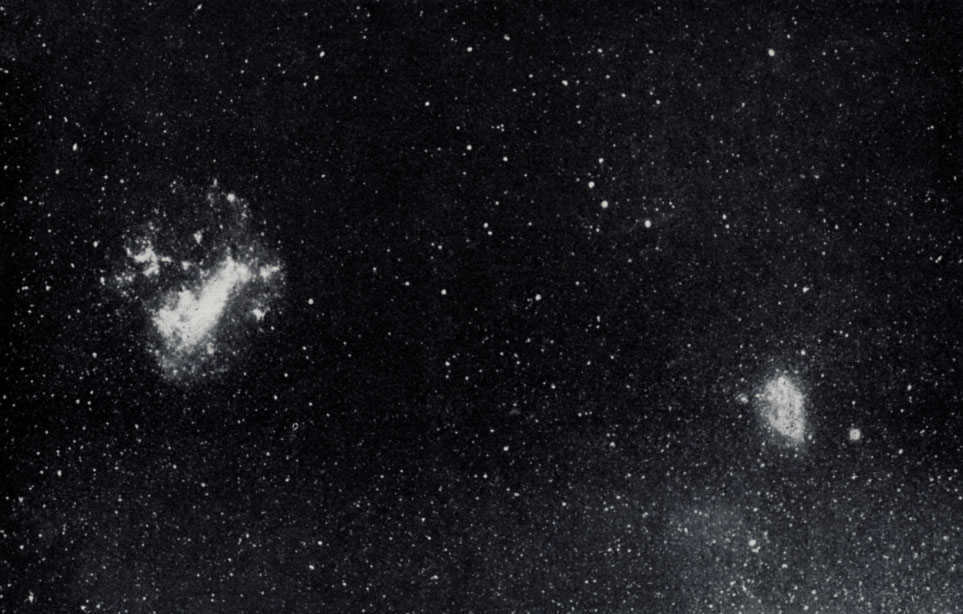
The nearest galaxy to our own is known as the Andromeda Nebula. It boasts an impressive size, making it easily visible from Earth with just a pair of binoculars, and under favorable conditions, it can even be seen with the naked eye.
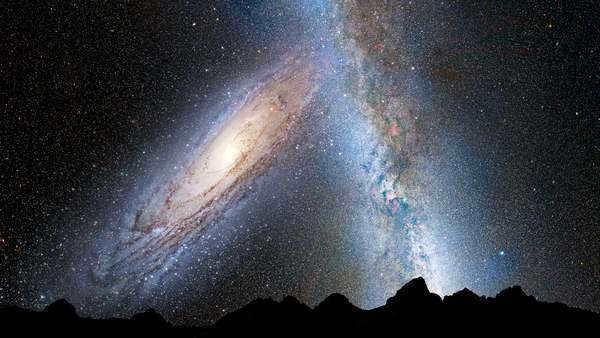
The galaxy has a striking resemblance to a colossal spiral shape that extends through space. Positioned on one of the spiral arms, roughly three-quarters the distance from the core, lies the solar system. Every celestial body within the galaxy orbits around the central nucleus, being influenced by the gravitational force it exerts. Back in 1962, astronomer Edwin Hubble categorized galaxies based on their morphology. He classified them into four main types: elliptical, spiral, irregular, and lenticular galaxies.
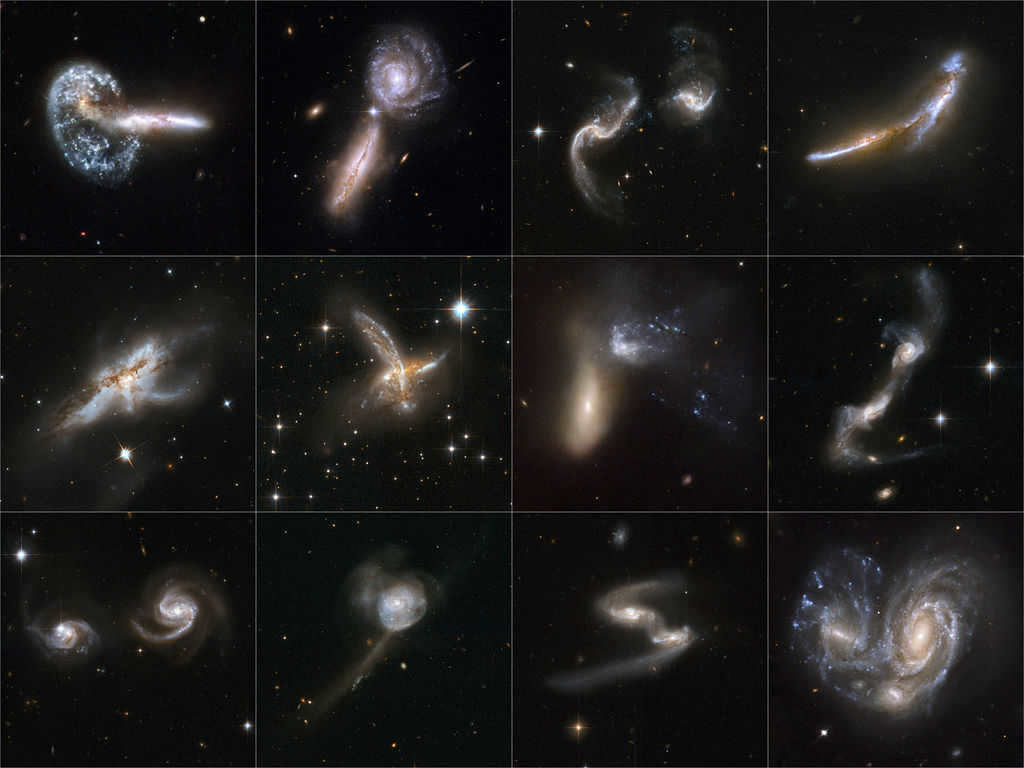
Within the portion of the cosmos that is accessible for astronomical investigation, there exist countless galaxies. Collectively, astronomers refer to them as the Metagalaxy.
The Galaxies of the Universe
Galaxies are vast collections of stars, gas, and dust that are bound together by the force of gravity. They can exhibit a wide range of shapes and sizes. The majority of celestial objects are affiliated with some galaxy. These include black holes, asteroids, stars with orbiting satellites and planets, nebulae, and neutron stars.
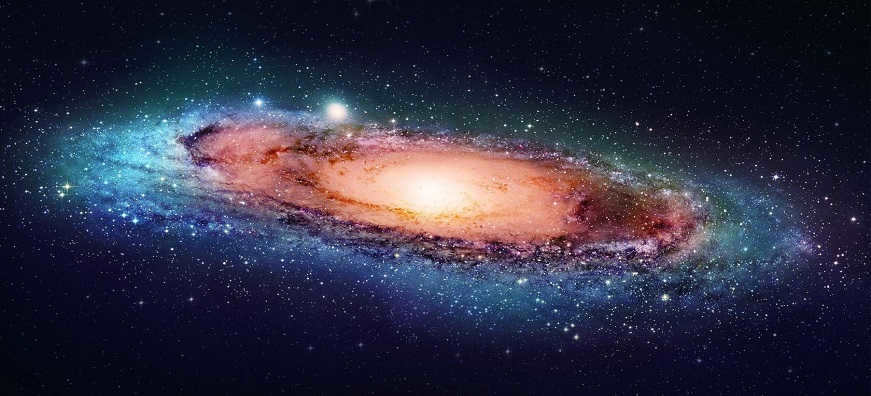
The phenomenon of spiral galaxies
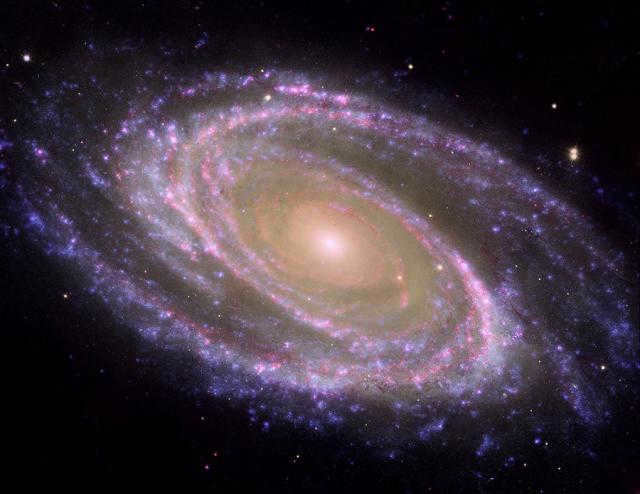
There exist galactic formations that possess a shape resembling a flat spiral disk with a luminous center, also known as the nucleus. One example of such a spiral galaxy is the Milky Way. These spiral galaxies are commonly denoted using the letter S and can be further divided into four subcategories: Sa, So, Sc, and Sb. The Sao subgroup is characterized by a nucleus of light coloration that lacks spiral arms. On the other hand, Sa galaxies are known for their tightly wrapped, dense spiral arms surrounding the central nucleus. In the case of Sc and Sb galaxies, their spiral arms are less likely to encircle the nucleus.
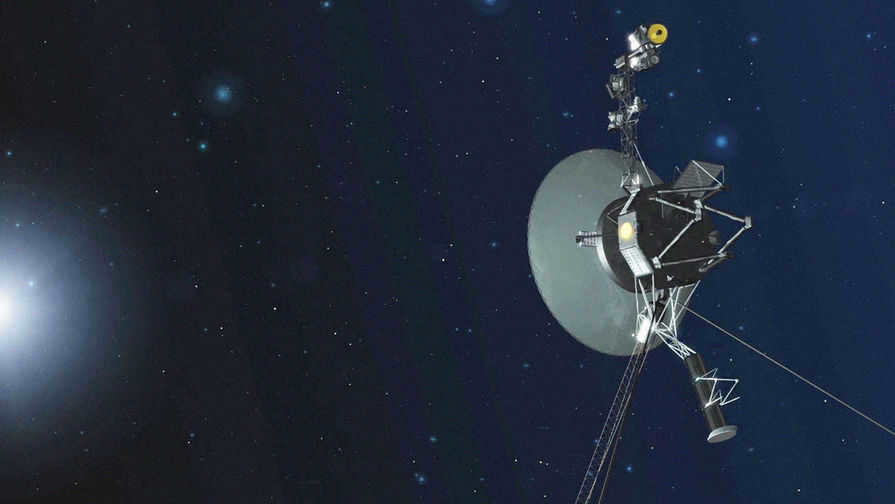
Researchers have recently released the inaugural findings from the Voyager 2 spacecraft, which was dispatched to the outermost reaches of the solar system. This new data provides valuable insights into certain aspects of the solar system’s periphery, while also presenting scientists with fresh enigmas.
The American Voyager 2 spacecraft has now officially departed from the solar system’s edge. After conducting a meticulous analysis of the collected data, scientists have verified that Voyager 2, much like its predecessor Voyager 1, has successfully crossed the heliopause, a protective barrier comprised of charged particles and a magnetic field generated by the Sun. Consequently, Voyager 2 is currently traversing interstellar space, progressively moving further away from our Sun.
A team of American astronomers has simultaneously published five scientific papers in the esteemed journal Nature Astronomy, which collectively confirm Voyager 2’s exit from the solar system on November 5, 2018.
At a distance of 119 astronomical units from the Sun (which is equal to the distance from Earth to the Sun), or approximately 17.8 billion kilometers, it was located.

The findings from the five papers provide a comprehensive understanding of the transition zone between the Sun’s sphere of influence and the interstellar medium. Each paper focuses on a different scientific instrument still present on the probe, including a magnetic field sensor, two high-energy particle recording instruments, and two space plasma study instruments. These instruments have collected valuable data that contribute to our knowledge of this region of space.
The heliosphere encompassing the Solar System resembles a vessel traversing through the interstellar medium; it is propelled in the direction of its own movement. Both the heliosphere itself and the interstellar medium are populated by plasma – atoms lacking electrons. Granted, the plasma within the heliosphere is hotter and more dispersed, whereas the plasma beyond it is cooler and more concentrated. Cosmic rays composed of charged particles accelerated to immense energies also propagate within interstellar space. Previous findings from Voyager 1 demonstrated that the heliosphere shields the Earth from 70% of this destructive radiation.
Upon Voyager 2’s departure from the solar system, its two instruments yielded unexpected findings – the quantity of “solar” charged particles plummeted significantly, while the number of interstellar particles with elevated energies surged.
“Voyager 1” became the first spacecraft to exit the solar system in 2012, prior to which scientists were uncertain about the precise location of the boundary between the Sun and interstellar space. Both Voyager spacecrafts departed the solar system, each heading in a different direction and at different points in the 11-year solar cycle, which is characterized by periods of high and low solar activity. Scientists theorized that the heliopause, the boundary between the heliosphere and interstellar space, may fluctuate in sync with solar activity, resembling the expansion and contraction of light. This hypothesis is supported by the observation that the two spacecrafts crossed the boundary at varying distances from the Sun.
Plasma
At present, both spacecraft have verified that they are traversing through plasma, which is considerably colder and denser than what they encountered previously. In 2012, Voyager 1 observed that right after crossing the boundary, despite the decrease in this parameter, the plasma density was slightly higher than anticipated, suggesting that the plasma in this region is being compressed by an unknown force. A similar phenomenon was observed by the instruments aboard Voyager-2, and scientists are still in the process of comprehending the mechanism behind this occurrence.
Particle Leakage
A small stream of charged particles breaking through the heliosphere from the solar system into the interstellar medium was detected by one of the instruments on the second “Voyager” spacecraft. Unlike the first probe, which did not record such leaks, scientists attribute the differences to the fact that both vehicles crossed the border in different directions, and the location where the second “Voyager” passed through was more “permeable”.
Magnetic anomaly
Confirmation of the unforeseen findings observed by its predecessor seven years ago has been provided by data from Voyager 2: the magnetic field lines outside the heliopause boundary align with the force lines within the heliosphere. Due to the limited data from a single instrument, scientists were unable to ascertain whether this characteristic is consistent throughout the entire solar system or merely a coincidental occurrence. However, the data collected from both probes now indicate that this magnetic field line arrangement is a systematic occurrence across the solar system.

When you gaze at the night sky, you can observe several planets from our solar system, along with thousands of other stars. In fact, there are an astounding billion million stars in the universe, with even more yet to be discovered!
The universe is comprised of numerous galaxies, each containing countless stars and celestial objects such as galaxies, constellations, nebulae, and star clusters. Among these, within the Milky Way galaxy, exists a planet that may be the only one inhabited by intelligent life.
This planet is known as our home – Planet Earth.
The arrangement of planets and other celestial bodies that orbit the sun is known as the solar system.
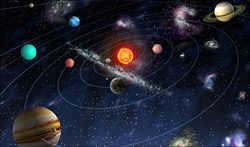
Our current place of residence is the planet Earth. Planet Earth orbits around the Sun and is a component of the Solar System along with the other celestial bodies. The Solar System consists of a total of nine planets, each of which possesses its own satellites and rings. Within our solar system, one can observe the presence of comets, asteroids, and even entire clusters of these objects. Each entity within the solar system possesses its own intriguing and unique characteristics, with the exception of our very own planet Earth, which sustains life.
Within this particular section.

- The Sun
- Mercury
- Venus
- Earth
- The Moon, Earth’s satellite
- Mars
- Satellites of Mars
- Jupiter
- Jupiter’s rings and satellites
- Saturn
- Saturn’s rings and satellites
- Uranus
- Uranus’ rings and satellites
- Neptune
- Neptune’s rings and satellites
- Comets
- Asteroids
- Meteorites
- Dwarf planet Pluto
- Pluto’s satellites
- The Kuiper Belt and Oort Cloud
- Dwarf planets in the solar system
- Planets in other solar systems
Star formations in the vast expanse of the night sky
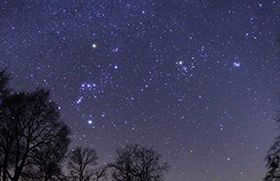
Centuries ago, ancient astronomers observed the movement of stars in the night sky and connected them with mythical stories, naming them constellations. Even today, we can still identify these familiar constellations and stars during each season of the year. Throughout the year, the positions of the stars change, except for the North Star, which remains a constant beacon at the Earth’s North Pole for thousands of years.
Section.
- Constellations and stars of the spring sky (March)
- Constellations and stars of the spring sky (April)
- Constellations and stars of the spring sky (May)
- Stars and constellations in the sky during the summer months of June
- Stars and constellations in the sky during the summer months of July
- Stars and constellations in the sky during the summer months of August
- Stars and constellations in the sky during the fall months of September
- Stars and constellations in the sky during the fall months of October
- Stars and constellations in the sky during the fall months of November
- Stars and constellations in the sky during the winter months of December
- Stars and constellations in the sky during the winter months of January
- Stars and constellations in the sky during the winter months of February
Stars and galaxies: A closer look at celestial wonders
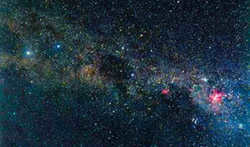
Our galaxy, known as the Milky Way, is extremely large, measuring 1 quintillion kilometers and spanning hundreds of thousands of light years. However, the universe contains other galaxies that are both near and far in comparison. These galaxies, similar to our own, are home to a wide variety of celestial objects including stars, nebulae, clusters of stars, black holes, white dwarfs, and red dwarfs, among many others.
Section.
- What is the process behind the formation of stars and planets?
- The ongoing evolution of stars and galaxies
- Understanding the nature of galaxies and stars
- Exploring the mysteries of nebulae
- How do astronomers measure the distance to stars and what exactly is a light year?
- Unveiling the secrets of supernovae
- Red dwarfs: the chilling stars of the universe
- White dwarfs: the cooling stars in the vast expanse of the universe
- Neutron stars: incredibly powerful generators of magnetic fields.
- Black holes: the ultimate cosmic abyss.
- The Milky Way Galaxy: our cosmic neighborhood.
- The Big Bang Theory: unraveling the origins and expansion of the universe.
- Exoplanets: potential havens for extraterrestrial life.
- Unveiling the mysteries of dark matter in the universe.
The relationship between humans and the universe
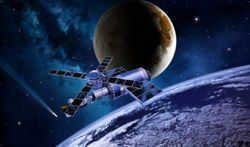
Since ancient times, humanity has been fascinated by the enigma of the celestial sky. People have invented and utilized telescopes, launched satellites into orbit, and even ventured into outer space themselves. They have developed methods to calculate distances and masses, and have managed to discover distant stars located hundreds of thousands of light years away. However, despite all these achievements, a significant portion of the cosmos remains shrouded in mystery and continues to captivate our curiosity.
Section.
- From Galileo’s groundbreaking telescope to the latest astronomical breakthroughs
- The development of the spectroscope
- The revolutionary advancements in 20th-century astronomy
- The advent of artificial satellites launched from Earth
- Humanity’s conquest of space
- The first spacecraft to land on another planet was used to explore Venus.
- The Galileo spacecraft was sent to explore Jupiter.
- Saturn was explored by the Cassini spacecraft.
- The MESSENGER spacecraft was used to explore Mercury.
- The Voyager 2 spacecraft explored Uranus and Neptune.
- Mars has been explored by the Spirit, Opportunity, and Curiosity rovers.
- The New Horizons spacecraft was sent to explore Pluto.
Science and Fiction
Science and fiction are two distinct domains that often intersect and inspire each other. While science is grounded in facts and evidence, fiction explores imaginative and speculative ideas. However, the boundaries between the two can sometimes blur, as scientific advancements can seem like something out of a fictional story, and fictional narratives can incorporate scientific concepts to create immersive worlds.
Science is a systematic approach to understanding the natural world through observation, experimentation, and analysis. It is based on empirical evidence and strives to discover and explain the underlying principles that govern the universe. Scientists seek to uncover the truth and expand our knowledge and understanding of the world around us.
On the other hand, fiction is a creative form of expression that allows authors to imagine and construct alternative realities. It can transport readers to different time periods, distant planets, or even parallel dimensions. Fictional stories often explore philosophical questions, social issues, and the complexities of human nature. They can also serve as a medium for scientific speculation, where authors imagine future technologies, extraterrestrial lifeforms, or scientific breakthroughs.
The relationship between science and fiction is a fascinating one. Science can inspire fiction by providing new ideas, concepts, and discoveries that authors can incorporate into their narratives. It can spark the imagination and push the boundaries of what is possible. Similarly, fiction can inspire science by presenting hypothetical scenarios and challenging scientists to explore new avenues of research. It can serve as a thought experiment, encouraging scientists to think creatively and critically about the implications of their work.
In recent years, there has been a growing trend of science fiction becoming science fact. Technologies that were once considered purely fictional, such as virtual reality, self-driving cars, and artificial intelligence, have now become a reality. This blurring of the lines between science and fiction highlights the power of human imagination and the potential for scientific advancements to shape our future.
In conclusion, science and fiction are two interconnected realms that fuel each other’s creativity and curiosity. While science seeks to uncover the truths of the natural world, fiction allows us to explore the possibilities beyond what is currently known. Together, they push the boundaries of what is possible and inspire us to imagine a better future.
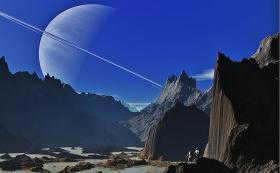
The vastness of the universe beckons humanity towards uncharted territories. Driven by the desire to explore the cosmos, mankind has defied the gravitational forces of our planet, making the solar system comprehensible to the inhabitants of Earth. Meanwhile, science fiction writers have expanded the realm of imagination, envisioning a universe where limits and boundaries cease to exist. In this fantastical realm, the human mind can one day explore and discover distant worlds.
Section.
- Reality:
- The velocities of space travel: first v1, second v2, third v3, and fourth v4
- Where is the Pioneer 10 spacecraft headed?
- What is the current location of the Voyager spacecraft?
- Where is the New Horizons mission heading after Pluto?
- On the verge of science fiction:
- The Mars expedition. A human presence on Mars
- Colonization of the Moon. Possibility of human life on the Moon
- Colonization of the Red Planet. Prospects of life on Mars
- Beyond science fiction:
- The bunker as an underground city. Life beneath the Earth
- The speed of light. How can we achieve the speed of light?
- Anabiosis. The sleep state for long-term space travel
- Interstellar travel to other galaxies.
- Generationship. Interstellar travel spanning multiple generations.
Our galaxy, known as the Milky Way, encompasses the Solar System, which consists of the Sun and nine planets orbiting around it. The third planet from the Sun is Earth, and it is from this planet that our journey to explore the vast and unfathomable universe began.
Science has already discovered numerous objects in the universe, but there are still many more that remain a mystery. As the universe continues to expand, there will always be new and fascinating discoveries to be made.
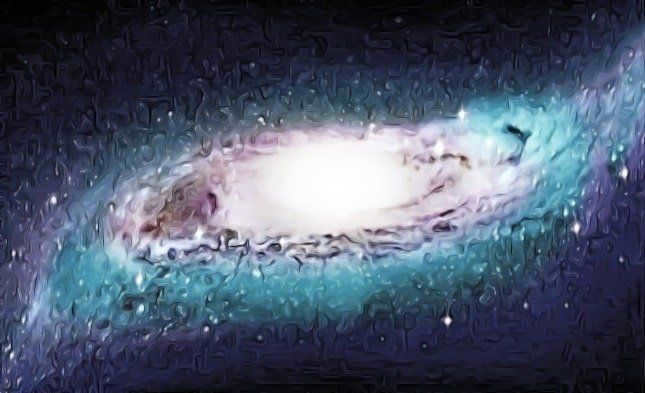
Back in 1999, astronomers made a fascinating discovery using the most up-to-date information and advanced techniques available. They found that the solar system completes one full orbit around the center of the Galaxy every 226 million years. Just imagine, our Sun and its planets gracefully gliding through the vastness of space, passing through ethereal spiral arms and the mysterious depths of dense nebulae… All while maintaining a constant distance of 27,000 light-years between Earth and the tumultuous galactic core.
A ballet in three dimensions
The orbit of our star system around the center of the Milky Way is not a perfect circle or ellipse. This is due to the complex nature of our Galaxy, with its uneven concentrations of masses and intricate gravitational fields. Furthermore, none of the components of our Galaxy remain stationary; they all partake in a sort of “three-dimensional ballet,” constantly rotating and drifting. As a result of this motion, our solar system, along with billions of other stellar systems, must inevitably traverse various regions of interstellar space. Some of these regions contain dense gas clouds, while others consist of tiny specks of dust. It typically takes tens of thousands to hundreds of thousands of years for a stellar system to pass through one of these regions.
There is a belief that the Solar System has completed approximately 20-25 rotations around the hub of the Galaxy throughout its lifespan. Alternatively, it has only accomplished 0.0008 rotations since the arrival of mankind. The eventual demise of our Sun will occur when its last flickers eventually diminish and extinguish. This event is predicted to transpire billions of years in the future. At that juncture, the solar system will have reached the age of 60 galactic years.
The solar system does not travel precisely in the same plane as the galaxy. It oscillates vertically in relation to the galactic disk. Throughout one complete orbit, the Sun and its accompanying planets pass through three of these “waves”. At present, the Sun is situated approximately 56 light years away from the galactic plane. However, this distance can reach greater than 300 light years. It takes approximately 80 million years for the Sun to transition between the highest and lowest points of its orbit.
So, it has been established that the Milky Way’s center is the focal point of the solar system’s revolution. As a result, the solar system moves both upwards and downwards in relation to the galactic disk. Consequently, the density of the gas and dust in the surrounding area can vary significantly. This is due to the fact that there are certain regions in our Galaxy where stars and gas are more closely packed together than in other areas.
Currently, the density of matter in the interstellar medium near the Sun is relatively low. However, periodically, the Sun traverses through molecular clouds. This occurrence takes place every few hundred million years or so. During these times, the density of matter in the space surrounding the Sun increases to several hundred, or even several thousand, atoms per cubic centimeter. This could potentially have significant consequences for the Earth and its inhabitants.
The solar system currently finds itself in an unusual and isolated region of space. This particular “bubble” possesses a density of matter equivalent to approximately one hydrogen atom per every five cubic centimeters of space. However, in the ancient past, we must have traversed through significantly denser gas clouds, some of which spanned over 100 light years in diameter.
This occurrence can only transpire, as previously mentioned, once every few hundred million years. If human civilization were to have originated during such an event, we would only be able to observe the nearest stars in the sky, remaining oblivious to the rest of our galaxy and the objects beyond. Is it possible that such circumstances could have impacted life on our planet? Could the passage of interstellar clouds or the presence of nearby sources of ionizing radiation have potentially hindered the emergence of life on Earth altogether?

